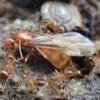1. Location of collection: Wisconsin
2. Date of collection: 3/16/17
3. Habitat of collection: The bark they were found under, was originally from the woods, then placed in our yard.
4. Length (from head to gaster):WORKERS A little over 1/4 of a centimeter.
5. Color, hue, pattern aND texture: Light brown.
6. Distinguishing characteristics: N/A
7. Distinguishing behavior: I noticed these ants would full blown out Walk backwards, and I was not seeing things. I am dead serious.
8. Nest description: Under bark of log.Very moist
Ok, so this is a colony I found today, under bark of a log I got from the woods. They were hibernating in a big pile. I can not say if there was a queen because I just flipped the the bark over and dumped them in the jar. A lot of larvae and eggs, and I would say there was 300-400 workers.























